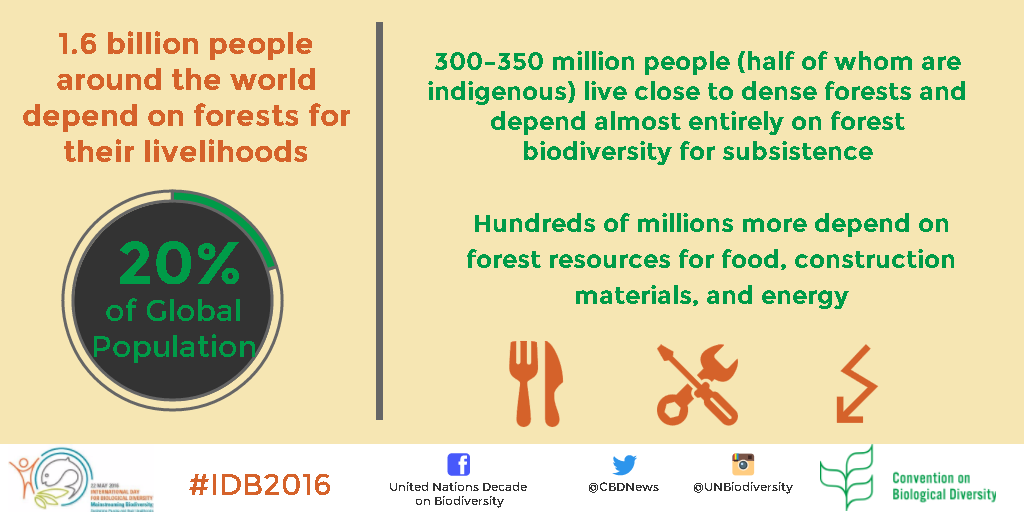International Day fo Biological Diversity
"Biodiversity is an important cross-cutting issue in the 2030 Agenda for Sustainable Development."
UN Secretary-General Ban Ki-moon
The United Nations has proclaimed May 22 The International Day for Biological Diversity (IDB) to increase understanding and awareness of biodiversity issues.
Biodiversity is the foundation for life and for the essential services provided by ecosystems. It therefore underpins peoples’ livelihoods and sustainable development in all areas of activity, including economic sectors such as agriculture, forestry, fisheries and tourism, among others. By halting biodiversity loss, we are investing in people, their lives and their well-being.
The 2016 International Day for Biological Diversity is dedicated to the theme: ‘Mainstreaming Biodiversity, Sustaining People and their Livelihoods.’
This echoes powerfully the vision set forth in the 2030 Agenda for Sustainable Development and the Paris Climate Change Agreement.
The 120 UNESCO Global Geoparks, in 33 countries, play a major role in geo-heritage protection and education, contributing to biodiversity conservation.
credits: infographics UN
Forests:
"Forests cover 30 per cent of the Earth’s surface and in addition to providing food security and shelter, forests are key to combating climate change, protecting biodiversity and the homes of the indigenous population. Thirteen million hectares of forests are being lost every year while the persistent degradation of drylands has led to the desertification of 3.6 billion hectares.
Deforestation and desertification – caused by human activities and climate change – pose major challenges to sustainable development and have affected the lives and livelihoods of millions of people in the fight against poverty. Efforts are being made to manage forests and combat desertification."
International Day fo Biological Diversity
credits: UN
Biodiversity:
- Of the 8,300 animal breeds known, 8 per cent are extinct and 22 per cent are at risk of extinction
- Of the over 80,000 tree species, less than 1 per cent have been studied for potential use
- Fish provide 20 per cent of animal protein to about 3 billion people. Only ten species provide about 30 per cent of marine capture fisheries and ten species provide about 50 per cent of aquaculture production
- Over 80 per cent of the human diet is provided by plants. Only three cereal crops – rice, maize and wheat – provide 60 per cent of energy intake
- As many as 80 per cent of people living in rural areas in developing countries rely on traditional plant-‐based medicines for basichealthcare
- Micro-organisms and invertebrates are key to ecosystem services, but their contributions are still poorly known and rarely acknowledged.
Education:
"Biodiversity is life. Is our life."
This day mobilise teachers, students, researchers on Biodiversity issues and their interdependence with global sustainable development issues.
Education can help to understand better the value of biodiversity and the causes of biodiversity loss.
- Curricula : Sciences ; Languages ; Civics.
- Levels : All levels. Different activities adapt to the level you are teaching.
Teachers will be inspired to prepare some pedagogical activities. Educators and students can get active and help conserve biodiversity.
- Teachers begin by suggesting to the students that they discover for themselves, with help, the exceptional beauty and richness of biodiversity.
- Educators introduce the concept of biodiversity : a general term denoting the variability of plants, animals and micro-organisms existing on Earth, their variability within a single species and also the variability of the ecosystems to which they belong.
Broadly speaking, biodiversity covers genetic diversity, the diversity of species and the diversity of habitats and ecosystems.
- In order to carry out the activities, they go outside and look a fresh at their natural surroundings, accompanied and guided by their teacher.
- They learn how to observe, to “read” their environment better, to examine it in detail and to see things they may never have noticed before. and to distinguish different environments where biodiversity exists in various forms.
- Students can get some pics using mobile devices (tablets; smartphones).
- Include the social networks into the curricula (Twitter, Instragam, Facebook, Google+ to share experiences with other schools.
- Explore Google Earth. Let your students find and explore the theme.
This approach encourages the students to use their
senses to discover the environment.
Resources for Teachers:
Goal 15: Sustainably manage forests, combat desertification, halt and reverse land degradation, halt biodiversity loss
A Teaching Resource Kit for Mountain Countries: A Creative Approach to Environmental Education (pdf) English| French | Spanish
"It took billions of years to create the biosphere we now enjoy, with its incredibly rich diversity of plants and animals - it is our duty and responsibility to act now to preserve it for future generations."
Irina Bokova's message on the International Day of Biological Diversity
G-Souto
22.05.2016
Copyright © 2016-Souto'sBlog, gsouto-digitalteacher.blogspot.com®
Schools : Intl Day for Biological Diversity 2016 by G-Souto is licensed under a Creative Commons Attribution-NonCommercial-NoDerivatives 4.0 International License.




No comments:
Post a Comment